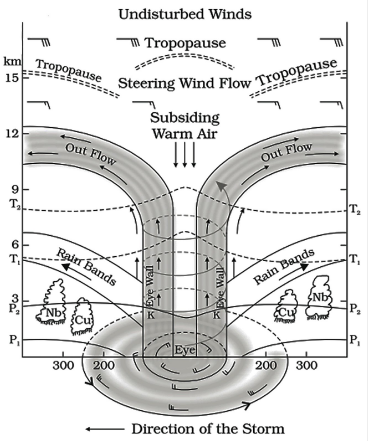Context:
Recently, a cyclonic storm, Biparjoy, swept through Gujarat and parts of Rajasthan.
About Cyclone Biparjoy:
- Biparjoy’ was suggested by Bangladesh and the word means ‘disaster’ or ‘calamity’ in Bengali.
- The storm was also categorized as falling in the ‘very severe’ category — average wind speeds of over 115 kmph.

Mechanism of Cyclone Formation:
- Essentially, Cyclone is a system of high speed winds rotating around a low-pressure area, with the winds blowing counterclockwise in the Northern Hemisphere and clockwise in the Southern Hemisphere.
- A mature tropical cyclone is characterized by the strong spirally circulating wind around the centre, called the eye.
- The eye is a region of calm with subsiding air. Around the eye is the eye wall, where there is a strong spiraling ascent of air to greater height reaching the tropopause.
- The energy that intensifies the storm, comes from the condensation process in the towering cumulonimbus clouds, surrounding the centre of the storm.
- With continuous supply of moisture from the sea, the storm is further strengthened.
- On reaching the land the moisture supply is cut off and the storm dissipates.

Image Credits: NCERT
Naming of Cyclones:
- Cyclones that form in every ocean basin across the world are named by:
- the Regional Specialized Meteorological Centres (RSMCs) and Tropical Cyclone Warning Centres (TCWCs).
- There are six RSMCs in the world, including the India Meteorological Department (IMD), and five TCWCs.
- As an RSMC, the IMD names the cyclones developing over the north Indian Ocean, including the Bay of Bengal and Arabian Sea, after following a standard procedure.
- In 2000, a group of nations called WMO/ESCAP (World Meteorological Organisation/United Nations Economic and Social Commission for Asia and the Pacific), decided to start naming cyclones in the region.
- It comprises Bangladesh, India, the Maldives, Myanmar, Oman, Pakistan, Sri Lanka and Thailand.
- After each country sent in suggestions, the WMO/ESCAP Panel on Tropical Cyclones (PTC) finalized the list.
- The list of 169 cyclone names released by IMD in 2020 were provided by these countries — 13 suggestions from each of the 13 countries.
Why is there more rise in development of cyclones in the Arabian sea in recent times?
- A cyclone is a low-pressure system that forms over warm waters.
- Usually, a high temperature anywhere means the existence of low-pressure air, and a low temperature means high-pressure wind.
- Because of climate change, the Arabian Sea side is also getting warmer, and as a result, the number of cyclones in the Arabian Sea is showing an increasing trend in the recent trend.
Way Forward:
- Frequent evacuation cannot be implemented as a permanent policy intervention and efforts must be made to ensure that coastal-regulation-zone norms that prescribe the kind of structures permissible at specific distances from the shoreline must be strictly implemented.
- The dwellings of rural, coastal inhabitants must be strengthened and natural bulwarks such as mangroves at wetlands must be buttressed for improved resilience.
News Source: The Hindu
![]() 19 Jun 2023
19 Jun 2023


